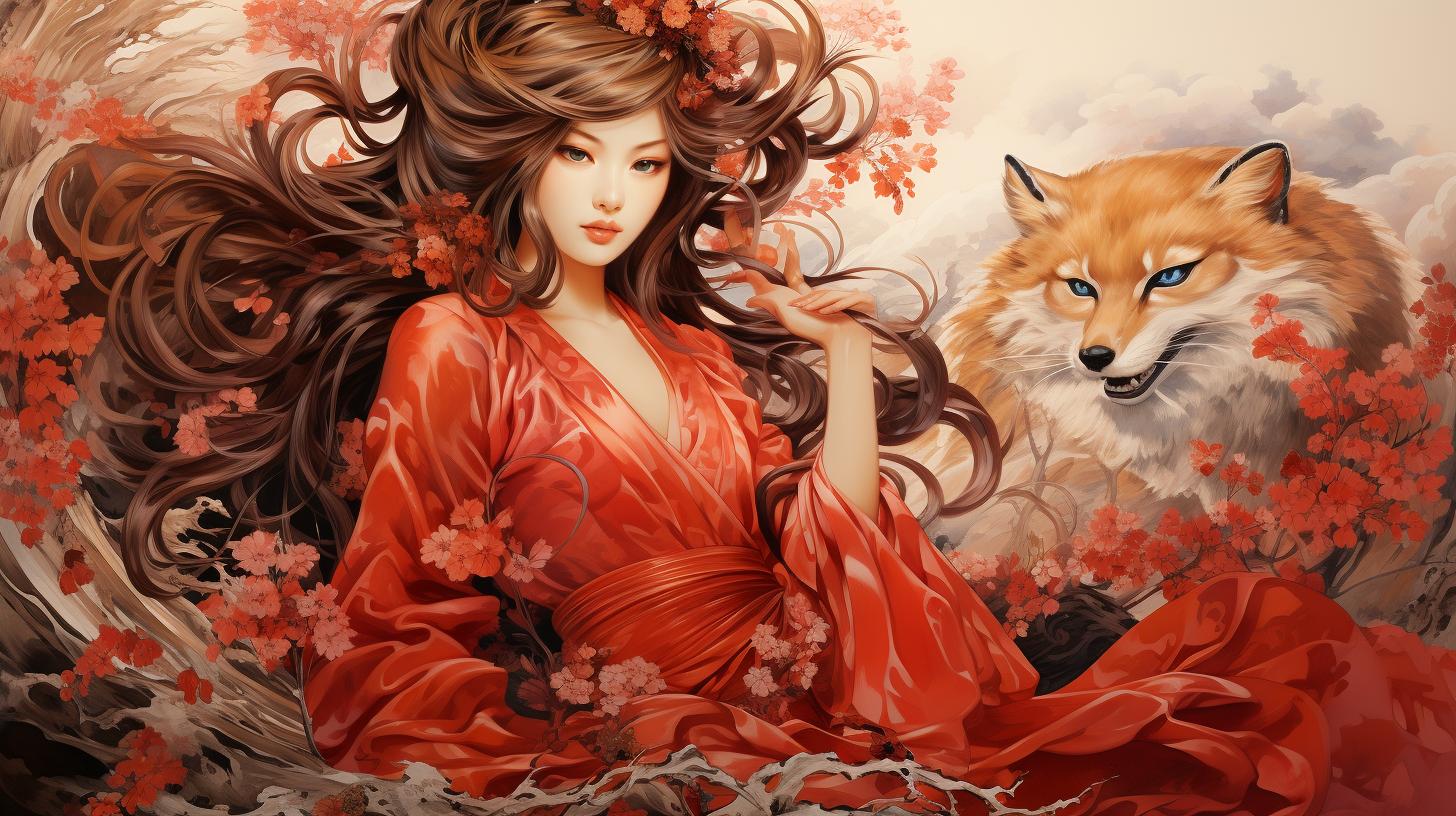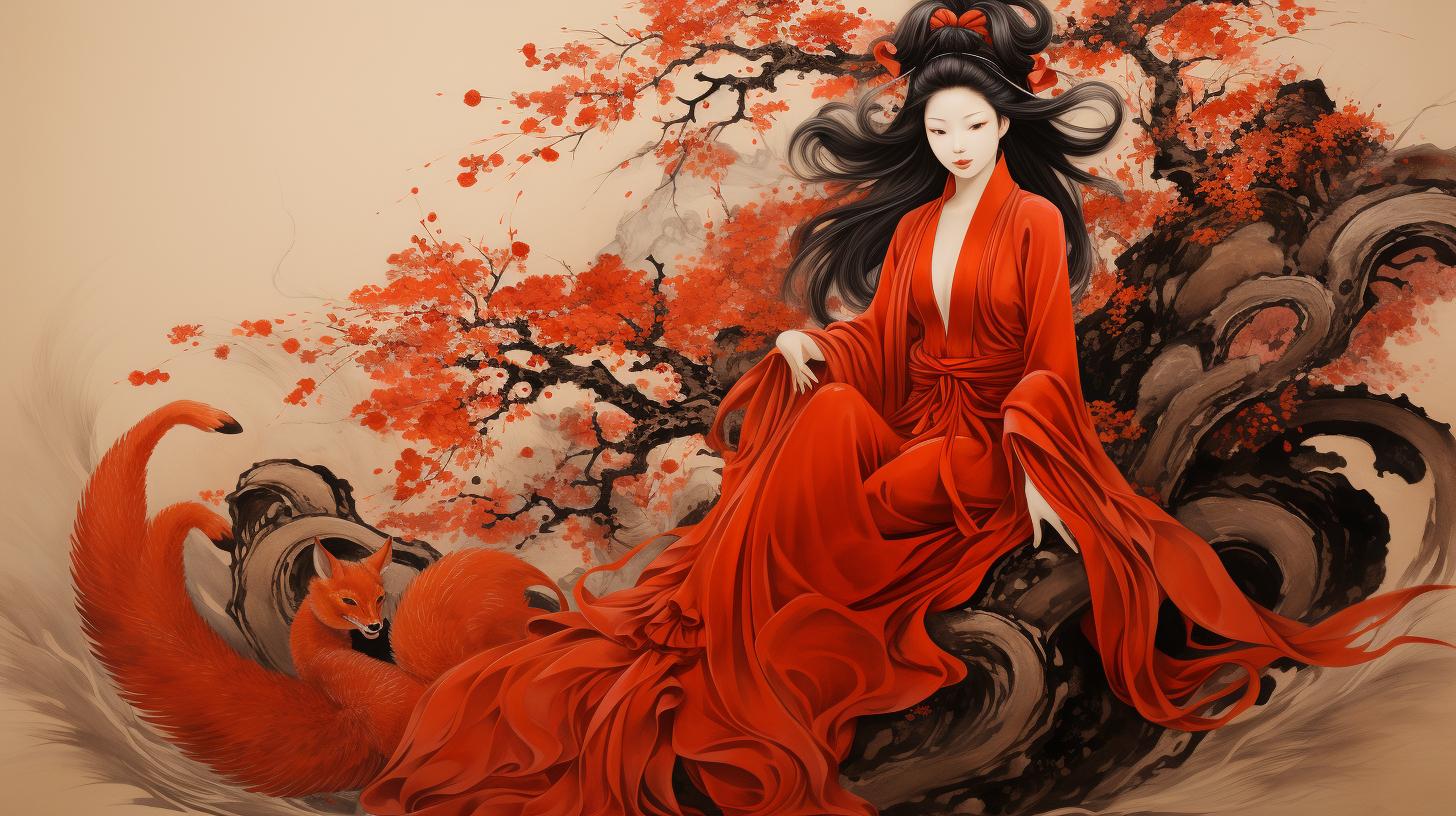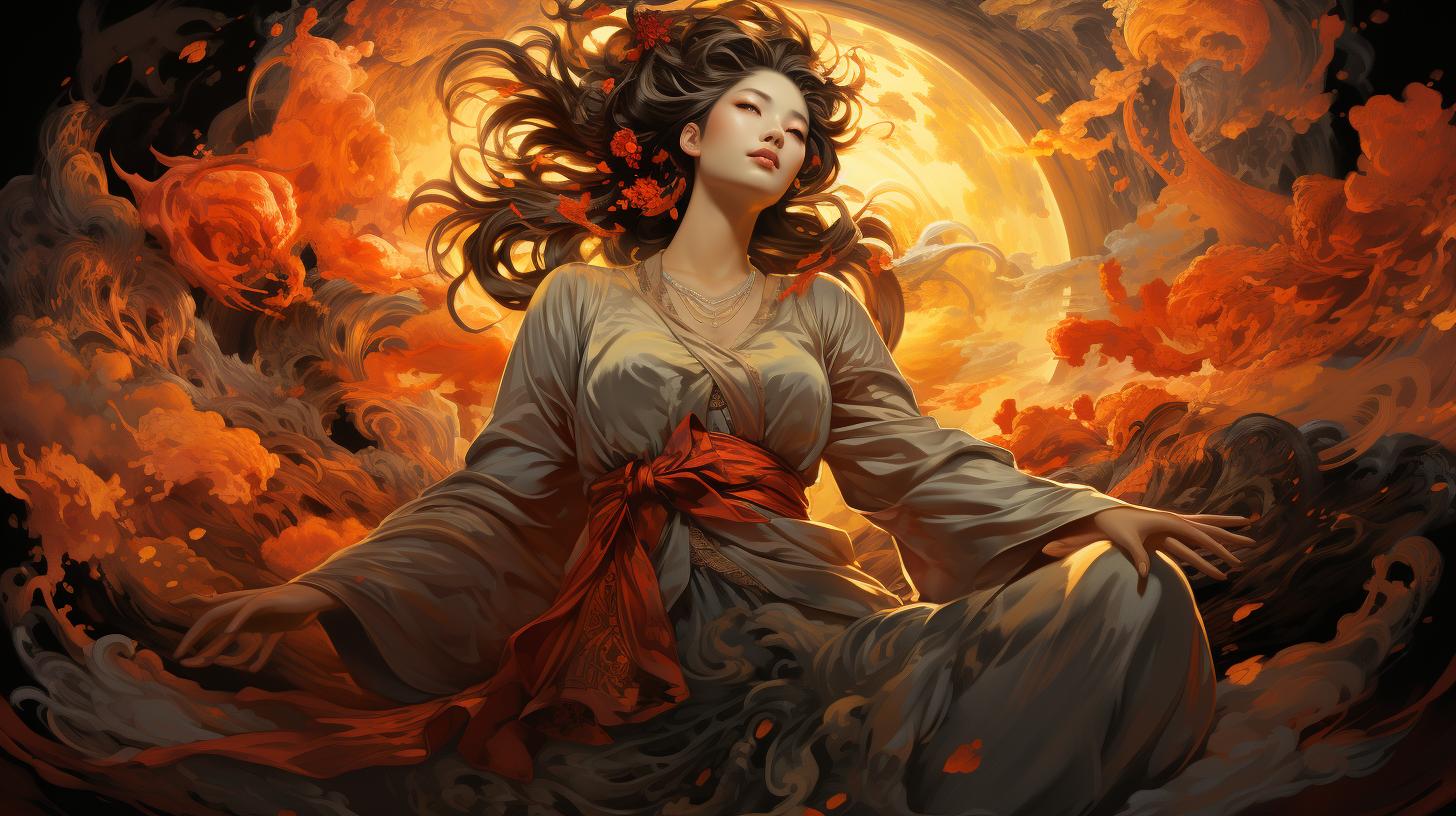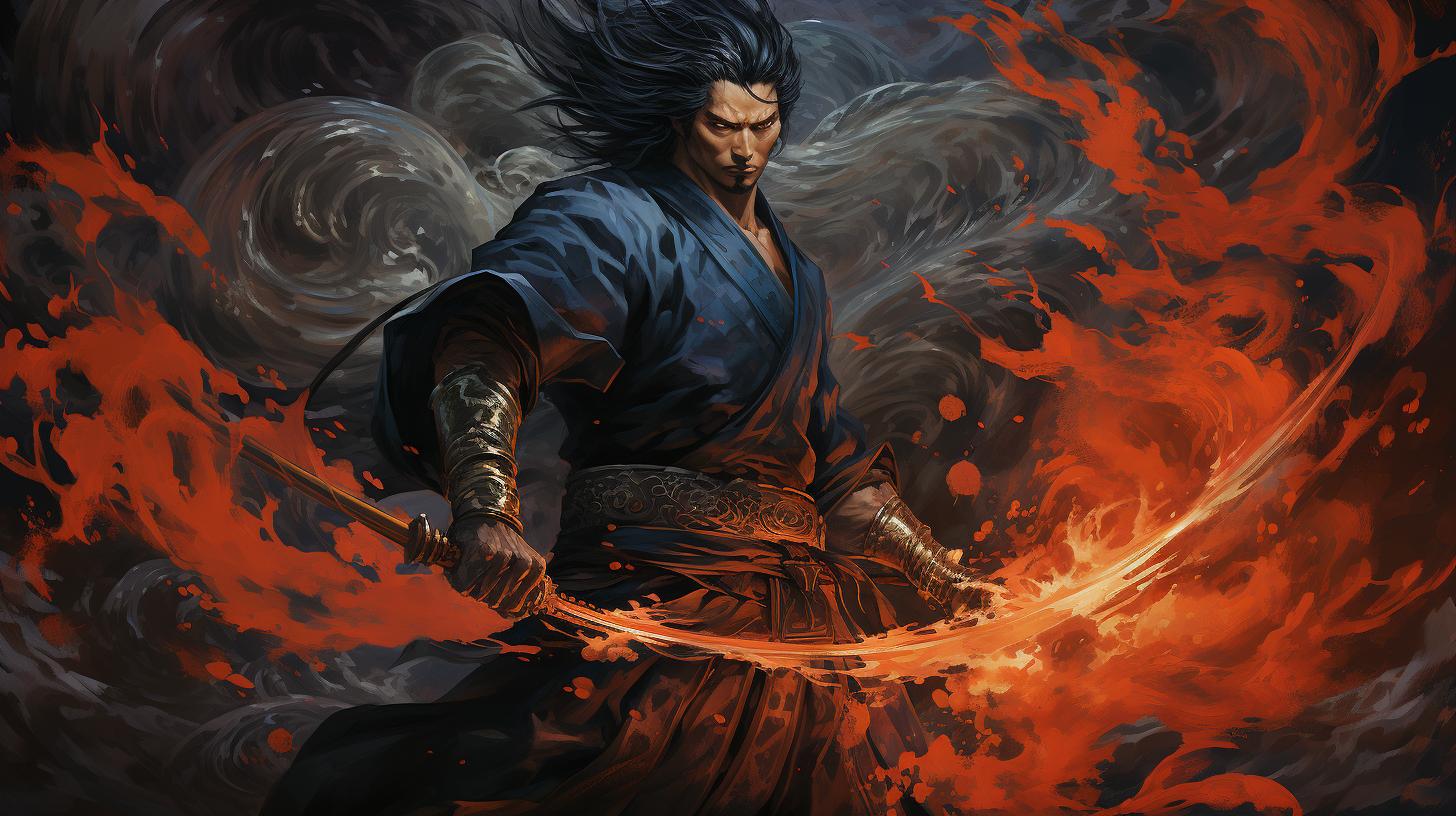Tamamo No Mae: Exploring the Yokai in Japanese Mythology

Tamamo No Mae yokai, a renowned figure in Japanese mythology, is a nine-tailed fox possessing the ability to transform into an alluring woman. Throughout history, she has been attributed with seducing and causing the downfall of powerful men.
This mystical being’s origins trace back to the Zhou Dynasty in China, where she was said to originally be a powerful sorceress. Tamamo No Mae’s captivating tamamo no mae story has been depicted in various art forms, including literature and theater, becoming an emblematic narrative in Japanese folklore.
Her arrival in Japan during the Heian period under the guise of a humble servant in the court of the Japanese Emperor Konoe brought dramatic events to a head. It was said that her manipulative actions led to the emperor’s illness, highlighting the dark influence of yokai on human affairs.
The spirit of Tamamo No Mae serves as a cautionary tale of seduction, manipulation, and the consequences of engaging with the supernatural realm.
Overview of Tamamo No Mae Yokai in Japanese Mythology
The legend of Tamamo No Mae story is deeply interwoven with the fabric of Japanese mythology.
Her story intersects with notable periods in Japanese history, including the Muromachi period, illustrating the enduring impact of yokai on cultural narratives. Her cunning and manipulative ways have made her one of the most revered and feared figures in folklore, embodying the complex relationship between the supernatural and the mortal world.
While Tamamo No Mae’s journey began in the Zhou Dynasty of China, her influence extended beyond, causing the downfall of dynasties and capturing the imagination of those who heard her tale.
She exemplifies the archetype of the fox spirit, or kitsune, a prevalent figure in Japanese mythology that often serves as a symbol of transformation and trickery. Her interactions with other mythical entities, such as Amaterasu and Susanoo, the deities of the sun and storms, showcase her pivotal role within the divine hierarchy.
The Origins and Evolution of Tamamo No Mae
Tamamo No Mae’s tale is a rich tapestry that spans continents and eras, illustrating her transformation from a mortal woman to a being of immense power and mystique. Her evolution from a sorceress in ancient China to a formidable yokai in Japan reflects the fluid nature of myth and the way these stories adapt over time to reflect the values and fears of society.
Her ability to traverse between worlds, impacting the courses of human history, from the Shang Dynasty to the courts of Japanese emperors, showcases the transcendent nature of yokai in folklore. Tamamo No Mae’s story is not just one of seduction and manipulation but also a reflection on the power of transformation and the enduring mystery of the supernatural.
Her encounters with creatures like jorōgumo, jubokko, and the mystical palace Ryūgū-jō, alongside confrontations with Satori, Sazae Oni, and the chilling Tsurara Onna Tsurubebi, enrich her narrative, weaving her into the complex fabric of Japanese mythology one story at a time.
In Japanese art and literature, Tamamo No Mae has been portrayed in myriad ways, from a cunning fox to a tragic figure caught between two worlds. Her narrative continues to evolve, reflecting the changing times while holding a mirror to the timeless themes of desire, power, and the consequences of our actions.
Exploring the Significance of Tamamo No Mae in Japanese History
Through her story, we gain a deeper understanding of the cultural and historical forces that shape our collective imagination and the enduring power of legend to influence, inspire, and caution.
As we delve deeper into the world of yokai and Japanese folklore, the legend of Tamamo No Mae stands as a testament to the intricate blend of myth, history, and culture.
Ancient Chinese Origins: Birth and Transformation
Deep-rooted in ancient Chinese folklore, Tamamo No Mae’s origins can be traced back approximately 3,500 years. Legend has it that she was born as a powerful sorceress with tremendous magical abilities, different from any other being of her time.
As time went by, her form gradually transformed into that of a nine-tailed fox, a yokai associated with cunning and enchantment, becoming a symbol of transformation and complexity in the mythological tapestry.
Influence
in China and India: Deception and Downfall
Under various aliases such as Daji, Lady Kayō, Bao Si, and Mikuzume, Tamamo-no-Mae (also referred to as Tamano no Mae, Tamamo no Mar, and Tamomo no Mae) wreaked havoc in China and India.
Her seductive wiles not only deceived but also manipulated influential rulers, ultimately causing the downfall of entire dynasties. She became an intelligent woman of formidable force, leveraging her supernatural powers as a yokai goddess and cunning nature to cut off the threads of power that held these dynasties together.
During her time in these lands, Tamamo-no-Mae‘s influence was not just limited to the courts; it extended into the realms of culture and spirituality, intertwining with local legends and folklore. In Japan, she became known not just as a malevolent figure but also as a complex character embodying both destruction and allure, a courtesan under the moonlight who whispered secrets to the wind.
The tamamo meaning, often associated with her mystical and enchanting nature, highlights her role as a tamamo yokai within Japanese mythology.
Connections to Other Mythological Figures
Tamamo-no-Mae yokai‘s story intersects with the narratives of other mythological figures, illustrating the interconnectedness of Asian folklore. From Amaterasu and Susanoo, deities of the Shinto religion, to creatures like Baku, who devours dreams, and Aka Manto, a malevolent spirit haunting public restrooms, her tale is woven into the fabric of myth across the continent.
In her journey across cultures and epochs, Tamamo-no-Mae encountered a variety of yokai and deities, from the enigmatic Abura Akago, a fireball-transforming infant ghost, to the mysterious Biwa Bokuboku, a lute possessed by the spirit of a tree.
Influence in China and India: Deception and Downfall
Under various aliases such as Daji, Lady Kayō, Bao Si, and Mikuzume, Tamamo No Mae wreaked havoc in China and India.
Through her seductive wiles, she deceived and manipulated influential rulers, ultimately causing the downfall of entire dynasties.
Her cunning nature and supernatural powers made her a formidable force to be reckoned with.
Arrival in Japan: Manipulation and Discovery
Eventually, Tamamo No Mae made her way to Japan, where she disguised herself as a humble servant in the imperial court of Emperor Toba. Unbeknownst to the emperor, Tamamo No Mae was secretly shortening his lifespan, intending to seize control of the country.
However, her true nature was eventually revealed, leading to a ritual performed to banish her. The emperor’s forces were then dispatched to track her down and put an end to her malevolent influence once and for all.
The complex journey of Tamamo No Mae (tamame no mae), deriving from “tamamo name meaning” as the most beautiful and mystical fox, and “no mae meaning” indicating her presence before all, from her ancient Chinese origins during the Zhou dynasty, through her manipulative exploits in China and India, to her arrival and deception in Japan during the Edo period and the Muromachi era, showcases the evolving nature of this yokai and elucidates her lasting impact on Japanese mythology and history.
Tamamo No Mae in Japanese Art and Literature
Tamamo No Mae, the captivating yokai of Japanese mythology, has left an indelible mark on various forms of artistic expression throughout history. From literature inspired by tales like Yotsuya Kaidan to theater, her intriguing story, encapsulating the essence of tamamo no mae folklore, has captivated the imagination of artists and audiences alike, giving rise to a plethora of artistic interpretations.
In Japanese literature, Tamamo No Mae’s tale has been a recurring theme. Numerous authors have reimagined her story, providing their own unique perspectives and adding layers of depth to her character, often depicted as “the nine tailed fox,” alluding to her as one of the most beautiful and powerful entities.
These literary works often explore the themes of seduction, power, and the consequences of manipulation, drawing parallels with stories of other legendary figures such as Ibaraki Dōji and Hone Onna. From epic poems to novels, Tamamo No Mae’s presence is felt, allowing readers to delve into the complexities of her persona and the impact she had on those she encountered, including her interactions with mythical beings like Ittan Momen and Koto Furunushi.
Artists throughout history have been inspired by her enchanting allure, depicting her in different ways and capturing the essence of her mythical persona. From serene paintings showcasing her beauty to dramatic theatrical prints portraying her manipulation, each artwork breathes life into the ancient yokai.
Theater, too, has embraced Tamamo No Mae as a compelling character. Kabuki, a traditional Japanese theatrical form, has seen numerous adaptations of her story, including references to her mysterious encounters like those with Urashima Tarō, bringing her seductive and manipulative nature to the stage, captivating audiences with stunning costumes, expressive gestures, and mesmerizing dance sequences.
The Symbolic Meaning in Art and Literature
Tamamo No Mae’s portrayal in art and literature goes beyond her mythical reputation as a seductress and manipulator. She represents profound symbolic meanings that resonate with the human experience. Through her character, artists and writers explore themes of temptation, the fragility of power, and the consequences of unchecked desires.
- Temptation: Tamamo No Mae’s ability to transform into a beautiful woman highlights the allure of temptation and the dangers it can bring. Artists often emphasize her enchanting features, drawing attention to the irresistible magnetic pull she exerts on the unsuspecting, akin to the chilling allure of the Yuki Onna.
- Fragility of Power: Tamamo No Mae’s role in the downfall of powerful men, including the legendary King You, serves as a cautionary tale about the vulnerability of those in positions of authority.
Artistic representations often depict her as a catalyst for the crumbling of empires and the demise of rulers, highlighting the fragility of power and the consequences of succumbing to manipulation.
- Unchecked Desires: Tamamo No Mae embodies the consequences of unchecked desires.
Her insatiable thirst for power and manipulation led to her own downfall. Artists and writers explore the dangers of yielding to one’s darkest desires and the repercussions it can have on both individuals and society.
Through art and literature, Tamamo No Mae continues to be an intriguing and complex figure of Japanese mythology, captivating audiences with her seduction, manipulation, and the profound themes she represents.
Each artistic interpretation adds layers of interpretation, shedding light on the complexities of human nature and the consequences of our actions.
The Legend of Tamamo No Mae: Seduction and Betrayal
As one of the most captivating characters in Japanese mythology, Tamamo No Mae’s legend is defined by the themes of seduction and betrayal. Her allure as a beautiful woman proved to be a powerful weapon, as she ensnared the hearts and minds of influential men throughout history, drawing parallels with other enigmatic figures like Yosuzume and weaving a tapestry of intrigue and mystique that continues to fascinate to this day.
According to folklore, Tamamo No Mae’s journey began in ancient China, where she was born as a powerful sorceress capable of transforming into various forms. Under different names such as Daji, Lady Kayō, Bao Si, and Mikuzume, she lured and deceived rulers, ultimately causing the downfall of dynasties in China and India.
However, it was in Japan where Tamamo No Mae’s manipulation reached its climax. Disguised as a devoted servant in the court of Emperor Toba, she orchestrated a series of events that led to the emperor’s grave illness.
It was then revealed that Tamamo No Mae was, in fact, a kitsune—an intelligent and powerful fox spirit—intent on seizing control of the country.
Discovering the truth, the emperor’s advisors performed a ritual to rid the court of the malicious kitsune.
But Tamamo No Mae managed to escape, setting off a pursuit by an army determined to find and destroy her.
The legend of Tamamo No Mae stands as a cautionary tale, a reminder of the dangers of succumbing to beauty and charm.
Her story serves as a testament to the complex nature of mythical creatures and their ability to manipulate human affairs. It offers a glimpse into the dark undercurrents that can emerge when power and desire intertwine.
To this day, Tamamo No Mae’s legend continues to captivate audiences, and her story has been reimagined in various forms of Japanese art, literature, anime, manga, and video games. Through these interpretations, her seductive power and the consequences of her intrigue live on.
Unveiling the Yokai: Characteristics and Abilities of Tamamo No Mae
Tamamo No Mae, the legendary yokai, possesses unique characteristics and formidable abilities that have captivated the imaginations of people throughout Japanese mythology. As a nine-tailed fox, she exudes both beauty and power, capable of transforming into a stunning woman at will.
This shape-shifting ability allows her to seamlessly navigate the human world, concealing her true nature and luring unsuspecting individuals into her intricate web of manipulation.
One of Tamamo No Mae’s most striking traits is her ability to manipulate others through her enchanting charm and seductive aura.
She effortlessly captivates and seduces powerful men, leading them down a path of destruction and downfall. Her allure lies not only in her physical beauty but also in her deep understanding of human desires and weaknesses.
In addition to her seductive prowess, Tamamo No Mae possesses immense magical powers. As a result of her centuries-long existence, notably during the Muromachi period, she has honed her skills as a sorceress and developed unparalleled mastery over various spells and enchantments, including mystic codes command.
She can cast illusions, read minds, and manipulate the elements to suit her needs, firmly establishing her as a pivotal figure in Japanese mythology one.
A notable aspect of Tamamo No Mae’s abilities is her control over fire.
With a mere flick of her tail, she can summon flames that engulf her surroundings. This connection to fire symbolizes her passionate and volatile nature, highlighting her formidable presence and the destructive potential she holds.
Her manipulation of fire also echoes the tumultuous tales of other entities like Tsurara Onna and Tsurubebi, further entwining her legend within the rich tapestry of yokai tales.
Furthermore, Tamamo No Mae’s divine fox nature grants her extended lifespan and regenerative abilities.
This resilience makes her a formidable adversary, as she can recover from injuries that would spell the end for ordinary beings. It is said that her nine tails represent her accumulated wisdom and power, further enhancing her supernatural abilities and mirroring the celestial might of deities like Amaterasu and Susanoo.
While Tamamo No Mae’s abilities make her a force to be reckoned with, they also mask the inherent danger she poses. Her cunning nature, combined with her manipulative skills and potent magic, make her a formidable and enigmatic creature in Japanese mythology.
Her story is interlaced with encounters with mythical beings such as Jorōgumo, Jubokko, Satori, and Sazae Oni, each adding depth to the tamamo no mae story.
Tamamo No Mae and the Fall of Emperor Toba
The captivating tale of Tamamo No Mae reaches its climax with the dramatic events surrounding the fall of Emperor Toba.
This section delves into the intriguing details of unmasking the Kitsune disguise and the subsequent ritual and pursuit that unfolded, invoking the sacred precincts of Ryūgū-jō in the process.
Unmasking the Kitsune Disguise
As suspicions started to arise regarding Tamamo No Mae’s true nature, a series of investigations sought to uncover her deceptive identity.
The truth eventually unraveled, exposing Tamamo No Mae as a Kitsune in disguise, a fox spirit manipulating the emperor and his court. This revelation not only confirmed her as the mastermind behind the emperor’s declining health but also showcased her deep-rooted influence in the annals of power, mirroring the complex relationships between humans and yokai.
Gathered evidence and testimonies established that Tamamo No Mae had been actively shortening the emperor’s life span, driven by her desire to grasp control over the nation. The revelation sent shockwaves throughout the palace, marking a turning point in the unfolding tale, and casting a shadow that would extend far beyond the confines of the imperial court, into the realm of legend and lore.
The Ritual and the Pursuit
To rid the court of Tamamo No Mae’s malevolent influence, a ritual was performed, combining ancient incantations and powerful magic. This sacred ceremony aimed to cleanse the court of her dark presence and protect the emperor from her harmful intentions.
Among the invoked powers were those of Amaterasu and Susanoo, deities known for their might and relevance in the cosmic balance, hinting at the depth of the ritual’s reach and echoing the tamamo no mae meaning in Japanese mythology as a figure of both beauty and doom.
Following the ritual’s completion, an army was dispatched to pursue and destroy Tamamo No Mae. The relentless pursuit spanned across treacherous landscapes and mystical realms, including the ethereal thresholds of Ryūgū-jō, the underwater palace known to house mythical treasures and wisdom.
The army’s determined efforts reflected the severity of Tamamo No Mae’s threat to the emperor and the kingdom, showcasing her tamamo no mae powers as she deftly maneuvered through these challenges.
The pursuit concluded in a climactic battle, where Tamamo No Mae faced off against the relentless forces deployed to eliminate her. The outcome of this legendary encounter, shrouded in myth and folklore, continues to be a subject of intrigue and speculation among enthusiasts of Japanese mythology.
Legends whisper of her transformation into the nine-tailed fox, a testament to her formidable powers and the extent of her treachery. This aspect of her being is a direct reflection of the tamamo no mae kitsune lore, symbolizing her ultimate form and nature.
As the story of Tamamo No Mae and her manipulative agenda against Emperor Toba reaches its climax, the events surrounding her fall highlight the extent of her treachery and the resilience of those who sought to protect the emperor and the kingdom.
Enigmatic beings of folklore, such as Abura Sumashi and Hitotsume Kozō Hitotsume, are rumored to have observed the battle from the shadows, adding layers to the tale’s mystique, much like the narratives surrounding tamama no mae and tanamo no mae, variants of her legend that emphasize her enigmatic presence.
Tamamo No Mae in Japanese Culture and Folklore
Tamamo No Mae holds a special place within Japanese culture and folklore, captivating the imaginations of people throughout the centuries. Her intriguing story and legendary status have inspired various forms of artistic expression, becoming an integral part of Japan’s cultural heritage.
Her story, deeply entrenched in the tamamo no mae legend and tamamo no mae story, continues to inspire and evoke curiosity.
1. Depictions in Visual Arts: Artists, ranging from traditional painters to contemporary illustrators, have portrayed Tamamo No Mae in a multitude of artistic mediums.
Paintings, woodblock prints, and manga (Japanese comics) have showcased her enchanting beauty and mythical nature, often incorporating motifs associated with her lore, such as Furaribi Fūri flames and the eerie Baku Basan, symbols of her connection to the supernatural.
These visual narratives reinforce the tamamo no mae name meaning as one that resonates with allure and mystery.
- The visual representations often emphasize her transformation from a fox into a stunning woman, capturing the duality of her existence.
This transformation is depicted with a depth of emotion and complexity, hinting at her battles and the internal strife of her existence between worlds.
- These artworks not only serve as aesthetic creations but also serve as a means of preserving and immortalizing the tales of the yokai in Japanese folklore, including her interactions with other mythical entities such as Funayūrei Furaribi Fūri and the mischievous Abura Akago Abura, further enriching the tapestry of her legend.
2.
Theatrical Performances: Tamamo No Mae’s captivating story has also found its place on the traditional Japanese stage. Noh and Kabuki, two prominent forms of classical Japanese theater, have adapted her tale and brought it to life through mesmerizing performances.
These adaptations often explore the nuanced facets of her character, from her alluring beauty to her formidable powers, and the profound symbolism she carries as a yokai figure entwined with the fate of emperors and the destiny of Japan itself.
- Actors don elaborate costumes and masks to portray the various aspects of Tamamo No Mae’s character, captivating audiences with their skillful performances.
- The theatrics serve as a reminder of the enduring power of folklore and its ability to captivate and entertain audiences across generations.
3.
Influence on Literature: Tamamo No Mae’s legend has permeated through Japanese literature, leaving its traces in numerous novels, poems, and literary works.
- Authors have explored her themes of deception, betrayal, and the consequences of misuse of power, weaving her story into the fabric of Japanese literary traditions.
- These literary works not only entertain but also provide deeper insights into the cultural significance and moral lessons associated with Tamamo No Mae’s character.
4.
Religious and Spiritual Significance: Tamamo No Mae’s yokai status has led to her veneration within certain religious and spiritual practices in Japan.
- In some folk beliefs, she is worshipped or revered as a deity to seek protection from misfortune or to invoke blessings.
- Her tale serves as a cautionary reminder of the consequences of falling prey to deceit and manipulation, making her a symbol of moral lessons within spiritual contexts.
In conclusion, Tamamo No Mae’s presence in Japanese culture and folklore is deeply rooted and multifaceted.
Through visual arts, theatrical performances, literature, and spiritual practices, her intriguing story continues to captivate and resonate with audiences, serving as a testament to the enduring power of myth and legend in shaping a nation’s cultural identity.
Comparative Analysis: Tamamo No Mae and Other Yokai
In the rich tapestry of Japanese mythology, Tamamo No Mae stands out as a fascinating yokai with her unique abilities and captivating story. However, when comparing her to other yokai, it becomes evident that she is part of a diverse and interconnected world of supernatural entities.
This section will explore the comparative analysis between Tamamo No Mae and two other prominent yokai: Shuten Dōji and the Oni.
Shuten Dōji and the Yokai Hierarchy
Shuten Dōji, often referred to as the “Demon King,” holds a significant place in Japanese folklore. While Tamamo No Mae is known for her manipulation and seduction, Shuten Dōji embodies raw power and monstrous characteristics.
He is depicted as a fearsome oni with a monstrous appearance and formidable strength.
When comparing Tamamo No Mae and Shuten Dōji, we see a stark contrast in their methods and objectives.
While Tamamo No Mae uses her wiles to deceive and manipulate, Shuten Dōji relies on brute force and terror to assert dominance. This comparison highlights the diverse nature of yokai and their varied roles within Japanese mythology.
Oni and Other Demonic Entities in Japanese Mythology
No discussion of yokai would be complete without mentioning the Oni, a class of demon-like entities often associated with evil and chaos. While Tamamo No Mae, as a kitsune yokai, possesses shapeshifting abilities and intelligence, the Oni embody different aspects of the supernatural.
The
Oni are often depicted as hulking, demonic creatures with various animalistic features, such as horns and fangs. They are known for their malevolent nature, causing havoc and tormenting humans. Unlike Tamamo Mae (tammamo no mae, tamamono mae), who primarily targets influential figures, the Oni pose a threat to all individuals they encounter.
In comparison, Tamamo No Mae’s manipulation and allure set her apart from the brute force displayed by many Oni. This juxtaposition showcases the wide range of traits and characteristics encompassed within the realm of yokai, further enriched by her interactions with other mythical entities such as Jorōgumo and Jubokko, enhancing the tamamo no mae japanese mythology narrative.
Conclusion
Exploring the comparative analysis between Tamamo No Mae, Shuten Dōji, and the Oni sheds light on the vast array of yokai archetypes present in Japanese mythology. Each entity possesses distinct traits, objectives, and roles within the realm of supernatural beings.
From Tamamo No Mae’s seductive abilities, illustrated in tales like Ikiryō and Ikuchi, to Shuten Dōji’s terrifying strength and the Oni’s malevolence, these comparisons showcase the dynamic and multifaceted nature of yokai in Japanese folklore, including the notable Hitotsume Nyūdō.
Exploring the Significance of Tamamo No Mae in Japanese History
As we delve into the significance of Tamamo No Mae in Japanese history, we uncover the immense sociopolitical influence and manipulation attributed to this enigmatic yokai. Through her ability to transform into a beautiful woman, Tamamo No Mae seduced and manipulated powerful men throughout various periods and regions, leaving a lasting impact on the political landscape, and became intertwined with stories such as Ryūgū-jō, reflecting her profound influence across tamamo no mae story and legend.
Sociopolitical Influence and Manipulation
Tamamo No Mae’s ability to influence and manipulate individuals in positions of power cannot be understated. Legends and historical accounts highlight her role in the downfall of emperors, dynasties, and ruling elites.
Through her seductive charms, she played a pivotal role in altering the course of history, often bringing about catastrophic consequences for those who fell victim to her manipulation. This narrative is deeply rooted in the tamamo no mae legend, where she is depicted as a tamamo no mae kitsune, weaving her way through the annals of time.
Furthermore, Tamamo No Mae’s actions reflect the delicate balance of power and control within Japanese society. The narratives surrounding her depict the vulnerability of influential figures when faced with temptation, as well as the repercussions that ensued.
Her story serves as a cautionary tale, reminding individuals of the potential dangers of unchecked desires and the consequences of succumbing to manipulation, a theme resonant in the mythological landscape of Kyoto, where tales of her exploits and encounters with beings like Abura Sumashi enrich the cultural tapestry.
Within the context of Tamamo No Mae’s impact on Japanese history, the city of Kyoto holds significant importance. Known as the imperial capital for over a thousand years, Kyoto served as the backdrop for the rise and fall of emperors, the seat of power, and a hub of culture, embodying the essence of her legendary status and the enduring allure that continues to captivate and intrigue.
Throughout
mythology and folklore, Kyoto is often featured as the stage for Tamamo No Mae’s manipulative schemes. As we explore the significance of this yokai, we learn about the intricate connections between Tamamo No Mae and the mythological landscape of Kyoto, including legendary places like Ryūgū-jō and interactions with deities such as Amaterasu and Susanoo.
Temples, palaces, and historical sites become intertwined with the legends of Tamamo No Mae, creating a landscape that embodies both beauty and treachery.
- The Kiyomizu-dera Temple: A site said to have played a role in the discovery of Tamamo No Mae’s true identity, showcasing the connection between spirituality and the uncovering of deception.
This temple’s history echoes tales of other mythical beings such as Jorōgumo and Jubokko, emphasizing the rich tapestry of tamamo no mae story within Kyoto’s borders.
- The Imperial Palace: Served as a residence for emperors, where Tamamo No Mae’s involvement led to tragic events and political instability.
Similar to the King Zhou of China, her manipulations were the cause of significant historical shifts.
- The Fushimi Inari Taisha Shrine: Symbolizes the intertwining nature of gods and yokai, where offerings and prayers are made to protect against manipulative forces.
The presence of entities like Ikiryō and Ikuchi in lore often highlights the blurred lines between the divine and the malevolent.
- Various Gardens and Landscapes: These serene environments represent the contrast between the beauty of nature and the cunning nature of Tamamo No Mae’s manipulations, reminiscent of the serene yet eerie settings where Yosuzume and Yuki Onna lure their victims.
By exploring the significance of Tamamo No Mae within the mythological landscape of Kyoto, we gain a deeper understanding of the cultural and historical context in which her story unfolds, alongside other notable figures such as Hitotsume Nyūdō and mythical elements like Akago Abura Sumashi.
Modern Perspectives and Interpretations of Tamamo No Mae
In contemporary times, Tamamo No Mae continues to captivate the imagination and inspire various interpretations in popular culture. Her compelling story of seduction, deceit, and supernatural powers has found its way into various forms of media, including anime, manga, and video games.
Many anime and manga adaptations depict Tamamo No Mae as a complex and alluring character, showcasing her shapeshifting abilities and her manipulative nature. These portrayals often explore her motivations and delve into her inner struggles as she navigates the human world, embodying the essence of the nine-tailed fox myth in modern storytelling.
In video games, Tamamo No Mae has become a popular character, often portrayed as a powerful and mysterious fox or fox-human hybrid. Players can take on her role, experiencing firsthand the allure and danger associated with her legendary status, echoing the intrigue and mystique that surrounds tamamo mae in tamamo no mae japanese mythology.
These modern interpretations of Tamamo No Mae serve as a testament to her enduring popularity and the timeless fascination surrounding her myth. They offer new perspectives and narratives that continue to breathe life into her compelling story, reaffirming her status as an iconic figure of power, mystique, and feminine allure in the rich tapestry of Japanese folklore.
Furthermore, Tamamo No Mae’s character is often used as inspiration for contemporary art and fashion. Artists draw upon her iconic nine-tailed fox form and her transformation into a beautiful woman to create stunning visual representations.
Her image has become a symbol of power, mystique, and feminine allure, reflecting the enduring legacy of tamamo no mae legend and tamamo no mae story in culture and media.
Researchers and scholars also continue to analyze and interpret the significance of Tamamo No Mae in Japanese culture and tamamo no mae mythology.
They examine the various layers of her story, seeking to uncover deeper meanings and connections to broader themes in Japanese history and society, including her ties to mythical locations like Ryūgū-jō, the undersea palace of the dragon god, and encounters with other yokai such as Baku Basan and Abura Sumashi.
Her origins are often traced back to the Shang Dynasty, highlighting her deep roots in tamamo no mae myth.
Ultimately, modern perspectives and interpretations of Tamamo No Mae demonstrate her timeless appeal and the enduring fascination with her role as a powerful and manipulative yokai.
Her lineage, believed to intertwine with divine figures like Amaterasu and Susanoo, showcases her as a pivotal figure in the pantheon of Japanese mythology and cultural heritage, often represented as the nine-tailed fox spirit of unparalleled beauty and cunning, a narrative that enriches the tamamo no mae story.
Tamamo No Mae in Popular Culture: Anime, Manga, and Games
An intriguing aspect of Tamamo No Mae’s mythological presence lies in her significant influence on popular culture, particularly in the realms of anime, manga, and video games. Over the years, numerous adaptations and reinterpretations of Tamamo No Mae have emerged, captivating fans worldwide.
Here, we explore some of the notable appearances of this compelling yokai, including her interactions with other mythical entities such as Furaribi Fūri, Hitotsume Kozō Hitotsume, Jorōgumo, and Jubokko, further enriching her diverse narrative.
Anime:
- Fate/Extra: Last Encore – Tamamo no Mae plays a prominent role as one of the main heroines in this popular anime series, intertwining with tales of Ikiryō and Ikuchi, showcasing her mystical abilities and deep connections to tamamo no mae japanese mythology.
- Fate/Grand Order: First Order – Another incarnation of Tamamo no Mae is featured in this anime adaptation, captivating viewers with her charm and mysterious powers, echoing the allure of Yosuzume and the frosty presence of Yuki Onna.
- Utawarerumono – Tamamo no Mae appears as a playful and mischievous fox spirit in this fantasy anime series, her cunning and mesmerizing skills in full display.
Manga:
- Fate/Extra CCC: Fox Tail – This manga series delves deeper into the story of Tamamo no Mae, showcasing her complex personality and interactions with other characters, including mythical figures like Abura Akago Abura and the eerie spirits of Funayūrei Furaribi Fūri.
- Nura: Rise of the Yokai Clan – Tamamo no Mae makes a brief appearance in this manga, adding an element of intrigue and power to the narrative.
- Ōkami-san and her Seven Companions – Tamamo no Mae is creatively reimagined as an elegant and formidable antagonist in this manga series, her story paralleling the legendary narratives of the nine-tailed beings and their impact on the human and supernatural world.
Video Games:
- Fate/Extra – Tamamo no Mae is a central character and potential companion in this action RPG, offering players the chance to explore her captivating abilities and tragic past, reminiscent of the tales that unfold within Ryūgū-jō.
- Onmyoji – Tamamo no Mae is a playable character in this popular mobile game, showcasing her cunning and mesmerizing skills in battle, a testament to her enduring legacy within tamamo no mae myth.
- Touhou Project: Perfect Cherry Blossom – Tamamo no Mae appears as a boss character, challenging players with her formidable abilities and intricate patterns of attack, mirroring the complexity and depth of her mythology.
These are just a few examples of how Tamamo No Mae has left an indelible mark on the world of popular culture, captivating audiences through her intriguing mythological origins and fascinating abilities.
Her appearances in anime, manga, and video games continue to spark the imagination of fans, further solidifying her status as a beloved and iconic figure in Japanese folklore.
Exploring Other Yokai in Japanese Mythology
In addition to Tamamo No Mae, whose tamamo no mae story weaves through Japanese mythology as a tapestry of intrigue and supernatural power, the folklore is rich with various other yokai creatures that captivate the imaginations of many.
From the alluring Yosuzume and icy Yuki Onna to the enigmatic Ikiryō and Ikuchi, these beings offer a glimpse into the complex world of Japanese supernatural entities.
Nyūdō, Miage Nyūdō, and Other Shapeshifting Yokai
The nyūdō and miage nyūdō are shapeshifting yokai that often take the form of wandering monks.
Alongside them, entities like the deceptive Jorōgumo and the life-draining Jubokko blur the line between benevolence and malevolence, leaving those they encounter filled with both fascination and fear.
Bokuboku, Boroboroton, and Chōchin Obake: Haunted Objects
Embarking on the realm of inanimate objects turned supernatural, we come across bokuboku, boroboroton, and chōchin obake, alongside other haunted entities such as Tsurara Onna and Tsurubebi.
These yokai embody haunted items such as scrolls, cushions, and paper lanterns, exhibiting mischievous behavior that often causes chaos and confusion.
Tanuki, Danzaburou, and Other Yokai with Animal Traits
Widely recognized for their animal traits, tanuki and danzaburou represent a fascinating category of yokai.
The tanuki, with its jovial nature, and danzaburou, with its vast strength, are joined by creatures like the elusive Nuppeppō and the master of illusion, Nurarihyon, in showcasing the diverse abilities and personalities that yokai can possess.
Onibaba, Kidōmaru, and the Dark Side of Japanese Folklore
Exploring the darker side of Japanese folklore, we encounter onibaba and kidōmaru, as well as entities that embody the terror of the night like Hitotsume Nyūdō. Onibaba, a demonic old woman, and Kidōmaru, a spider-like creature, instill a sense of fear and trepidation with their formidable supernatural powers.
These are just a few examples of the diverse and captivating yokai creatures found in Japanese mythology. Each yokai, from the Amaterasu and Susanoo-inspired tamamo no mae mythology to the enigmatic realms of Ryūgū-jō, brings its unique characteristics, stories, and lessons, further enriching the tapestry of Japanese folklore and enticing us to explore more of these intriguing entities.
Tamamo No Mae Yokai: An Intricate Blend of Myth and Legend
The legend of Tamamo No Mae continues to captivate audiences with its intricate blend of myth and legend. This mythical creature, known as a yokai in Japanese mythology, embodies the allure of the nine-tailed fox with the ability to transform into a beautiful woman.
But there is more to Tamamo No Mae than meets the eye, as her story unfolds in a complex web of deception, seduction, and ultimate downfall, making her one of the most profound figures in the tamamo no mae myth.
Rooted in ancient Chinese origins during the Zhou Dynasty, Tamamo No Mae’s journey begins as a powerful and intelligent woman who later transforms into a nine-tailed fox with supreme magical powers. Renowned by various names like Daji, Lady Kayō, Bao Si, and Mikuzume, she wreaks havoc in China and India, causing the downfall of powerful dynasties.
But it is in Japan, under the Japanese Emperor Toba during the Heian period, that Tamamo No Mae’s true intentions are revealed.
The yokai disguises herself as a servant in the court, only to be discovered when the emperor falls gravely ill.
Unveiled as a kitsune in disguise, Tamamo No Mae is revealed as the one shortening the emperor’s life to seize control of the country. A ritual, invoking mystic codes and commands, is performed to eliminate her, and an army is sent to hunt down and destroy her.
Throughout history, during the Muromachi period and beyond, Tamamo No Mae has been depicted in various forms of art, from literature to theater. Her story has captivated the imagination of artists and storytellers, allowing her to become an iconic figure in Japanese mythology, one that continues to fascinate and intrigue even in modern times.
The significance of Tamamo No Mae extends beyond her mythical existence. Her story serves as a cautionary tale of manipulation and the consequences of unchecked power. As a figure deeply entrenched in Japanese history, she represents the turmoil and struggles of past eras, akin to the way the stone remains immovable against the tides of time.
Comparative analysis with other yokai, such as Satori, Sazae Oni, Tsurubebi Tsurube Otoshi, and the cunning Jorōgumo and Jubokko, highlights Tamamo No Mae’s unique position within Japanese mythology. Shuten Dōji, another legendary yokai, and the hierarchy of yokai reveal the diverse spectrum of mythical creatures that inhabit Japanese folklore, each with its own story and powers, like Ikiryō Ikuchi, adding to the rich tapestry of legends.
As we explore the intricate blend of myth and legend surrounding Tamamo No Mae, we gain insights into the sociopolitical influences, manipulations, and the dark underbelly of Japanese folklore. Her tale is just one thread in the rich tapestry of yokai that continue to spark our imagination and curiosity, offering endless tales of yosuzume yuki onna, nuppeppō nurarihyon nure, and onna tsurubebi tsurube, amongst others, weaving a complex narrative of power, deception, and the supernatural.




















